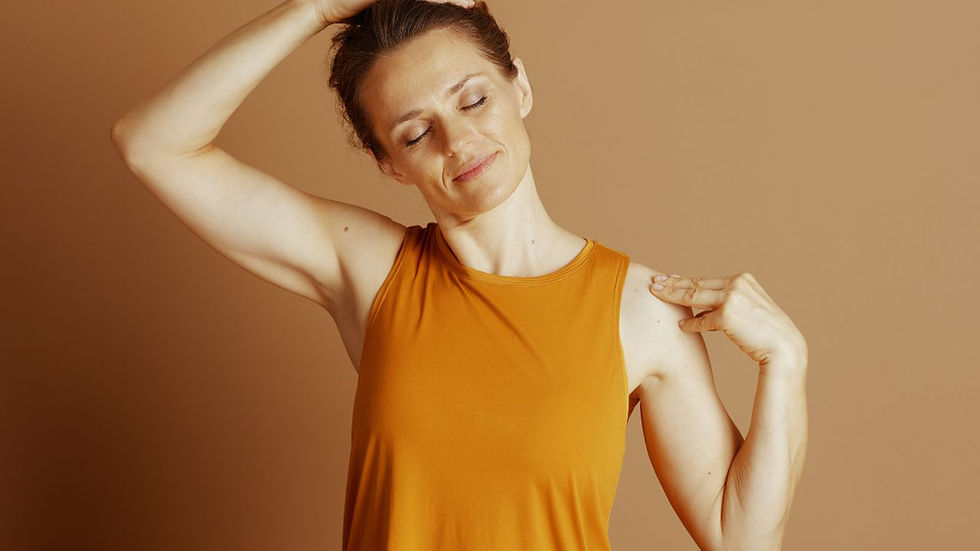Yoga Poses for Better Posture: A Path to Alignment and Strength
- Ken Belveal
- Mar 31, 2024
- 3 min read

In our modern lifestyle, dominated by desk jobs and smartphones, maintaining good posture has become a significant challenge. Slouching and poor posture can lead to a host of issues, including back pain, neck stiffness, and reduced energy levels. However, yoga, an ancient practice rooted in promoting physical, mental, and spiritual well-being, offers a pathway to improving posture through strength, flexibility, and awareness. This blog post introduces several yoga poses that are particularly effective for enhancing posture. Whether you're a seasoned yogi or new to the practice, incorporating these poses into your routine can lead to noticeable improvements in how you stand and carry yourself throughout the day.
1. Mountain Pose (Tadasana)
Why It Helps: Mountain Pose is the foundation of all standing poses in yoga. It teaches you to stand with strength and stability, aligning your spine over your pelvis and grounding through your feet.
How to Do It:
Stand with your feet together, pressing down through all ten toes as you spread them open.
Engage your quadriceps to lift your kneecaps and lift up through the inner thighs.
Draw your abdominals in and up as you lift your chest and press the tops of the shoulders down.
Feel your shoulder blades coming towards each other and open your chest, but keep your palms facing inwards towards your body.
Simultaneously, reach your head towards the sky while keeping your throat relaxed and your gaze straight ahead.
2. Cat-Cow Stretch (Marjaryasana-Bitilasana)
Why It Helps: This pose increases flexibility in your neck, shoulders, and spine; the fluid motion helps correct posture by aligning the spine and relieving tension in the torso and neck.
How to Do It:
Begin on your hands and knees in a "tabletop" position. Make sure your knees are set directly below your hips and your wrists, elbows, and shoulders are in line and perpendicular to the floor.
As you inhale, lift your chest and sit bones towards the ceiling, allowing your belly to sink toward the floor (Cow Pose).
On your exhale, round your spine toward the ceiling, tucking your chin to your chest and drawing your belly in (Cat Pose).
Continue flowing back and forth from Cat Pose to Cow Pose, and synchronize your movement with your breath.
3. Cobra Pose (Bhujangasana)
Why It Helps: This pose strengthens the spine, shoulders, and buttocks, while also stretching the chest, lungs, shoulders, and abdomen. It's excellent for correcting rounded shoulders.
How to Do It:
Lie prone on the floor with your legs extended back, tops of the feet on the floor, and hands under your shoulders.
Hug your elbows back into your body as you inhale and straighten your arms to lift your chest off the floor.
Keep a slight bend in the elbows and draw your shoulder blades back and down. Lift through the top of your head to increase the stretch and hold for 15 to 30 seconds.
4. Warrior I (Virabhadrasana I)
Why It Helps: Warrior I is a powerful pose that improves focus, balance, and stability. It strengthens the shoulders, arms, legs, ankles, and back; enhancing posture by opening up the chest and hips, which are often tight in individuals with poor posture.
How to Do It:
Start in a standing position, then step your left foot back about 3 to 4 feet, angling it at about 45 degrees.
Bend your right knee until it's over your right ankle, keeping the right thigh parallel to the floor.
Raise your arms overhead, reaching actively. Keep your torso upright and look straight ahead, or tilt your head back and look up at your thumbs.
Stay in this pose for 30 seconds to 1 minute, then switch sides.
5. Child’s Pose (Balasana)
Why It Helps: While primarily a resting pose, Child’s Pose is beneficial for gently stretching the hips, thighs, and ankles. It helps release tension in the back, neck, and shoulders, areas where poor posture often manifests.
How to Do It:
Kneel on the floor with your toes together and your knees hip-width apart. Exhale and lower your torso between your knees.
Extend your arms forward, placing your palms on the floor to lengthen your back. You can also place your arms alongside your body with your palms facing up for a more relaxed stretch.
Stay in the pose for up to a few minutes, focusing on deep, slow breaths.
Incorporating these yoga poses into your daily routine can lead to significant improvements in your posture, resulting in reduced back and neck pain, increased energy levels, and a more balanced and confident appearance. Remember, improving posture is a gradual process, and consistency is key. Practice these poses regularly, and listen to your body, adjusting as necessary to accommodate your flexibility and strength levels. Namaste!








Comments